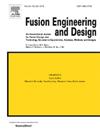Effect of HIP bonding temperature and duration on the interfacial microstructure and mechanical properties of W/steel joint with an Fe interlayer
IF 1.9
3区 工程技术
Q1 NUCLEAR SCIENCE & TECHNOLOGY
引用次数: 0
Abstract
HIP experiments were conducted at temperatures of 950, 900, and 850 °C for durations of 60, 135, and 240 min respectively in this study, the effect of bonding temperature and duration on the interfacial microstructure and mechanical properties of the joint was investigated. The results demonstrate that reducing the HIP temperature from 980 to 850 °C leads to a significant decrease in the thickness of the W/Fe reaction layer. This reduction enables bonding interfaces without reaction layer at temperatures of 900 and 850 °C. However, as the temperature decreases, there is an initial increase followed by a subsequent decrease in shear strength with a maximum shear strength achieved at 950 °C reaching up to 322 MPa. Prolonging the bonding duration at a temperature of 950 °C results in a rapid transition of W/Fe reaction layer from Fe2W to Fe3W3C which weakens the overall bonding performance. Conversely, increasing the bonding duration at temperatures of 900 and 850 °C has minimal impact on both interfacial microstructure and bonding strength.
HIP 焊接温度和持续时间对带有铁夹层的 W/steel 接头的界面微观结构和机械性能的影响
在本研究中,分别在 950、900 和 850 ℃ 的温度和 60、135 和 240 分钟的持续时间内进行了 HIP 实验,研究了接合温度和持续时间对接合界面微观结构和机械性能的影响。结果表明,将 HIP 温度从 980 ℃ 降到 850 ℃ 会显著减少 W/Fe 反应层的厚度。在温度为 900 和 850 ℃ 时,反应层厚度的减少使得接合界面没有反应层。然而,随着温度的降低,剪切强度会出现先上升后下降的情况,在 950 °C 时达到的最大剪切强度可达 322 兆帕。在 950 °C 温度下延长键合时间会导致 W/Fe 反应层从 Fe2W 快速转变为 Fe3W3C,从而削弱整体键合性能。相反,在 900 和 850 °C 温度下延长键合时间对界面微观结构和键合强度的影响都很小。
本文章由计算机程序翻译,如有差异,请以英文原文为准。
求助全文
约1分钟内获得全文
求助全文
来源期刊

Fusion Engineering and Design
工程技术-核科学技术
CiteScore
3.50
自引率
23.50%
发文量
275
审稿时长
3.8 months
期刊介绍:
The journal accepts papers about experiments (both plasma and technology), theory, models, methods, and designs in areas relating to technology, engineering, and applied science aspects of magnetic and inertial fusion energy. Specific areas of interest include: MFE and IFE design studies for experiments and reactors; fusion nuclear technologies and materials, including blankets and shields; analysis of reactor plasmas; plasma heating, fuelling, and vacuum systems; drivers, targets, and special technologies for IFE, controls and diagnostics; fuel cycle analysis and tritium reprocessing and handling; operations and remote maintenance of reactors; safety, decommissioning, and waste management; economic and environmental analysis of components and systems.
 求助内容:
求助内容: 应助结果提醒方式:
应助结果提醒方式:


